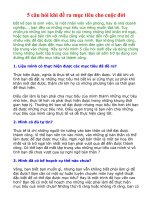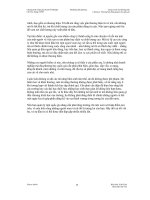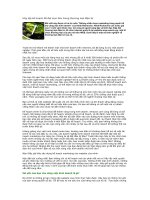Brand KPI _ đặt mục tiêu cho thương hiệu
Bạn đang xem bản rút gọn của tài liệu. Xem và tải ngay bản đầy đủ của tài liệu tại đây (6 MB, 80 trang )
Brand KPI
Setting Path to Growth
1
In your opinion, does Marketing take responsibilities for Brand Sales?
What is your Brand Sales target & growth rate for this year?
How do you set Brand Sales target for next year? On which indicator?
How do you get your Marketing budget?
What is your current Brand Share versus competitors?
How big is your category? In terms of size & growth?
What is your category Penetration? Frequency & Consumption habits?
How do you translate Brand Sales target to Marketing Objectives?
How do you translate Marketing Objectives into Communication Objectives?
2
“The role of Marketing is to get more consumers
aware of and in love with the brand,
buy more things, more frequently
and at higher prices.”
— The Role of Marketing
3
By the end of today, you’ll know…
Business
Objectives
Marketing
Objectives
4
Communication
Objectives
Business Objectives
Sales
Share
Growth
5
Profit
Basic KPIs
Sales
Share
Growth
6
Profit
Sales
Excercise:
Brand A sells 10,000 180gr-bottle of shampoo a year at a retail
price of 30,000 VND.
What are the Volume Sales and Value Sales of Brand A?
7
Sales
Volume Sales = the quantity, amount or number of products sold
or services provided
In Capacity (liquid milk, beverage, etc): liter, hectoliter…
In Weight (powder detergent, personal care, etc): kilogram (kg), ton…
In Counting Number (computers, phones, services, etc): pcs, unit, customers…
Value Sales = the amount of revenue that a company receives
from
the sale of products or services
In Monetary Unit: VND, US Dollar, Euro…
8
Sales
Note 1:
Volume Sales can’t be measured by bottle, box, pack... in
categories that use Capacity or Weight units, specially in FMCG,
because they may vary in sizes.
For examples:
1 box of Vinamilk = 180ml VS 1 box of Dutch Lady = 200 ml
This year, Vinamilk sold 10 mil. boxes > Dutch Lady sold 9.5 mil. boxes.
But in actual Volume Sales, Vinamilk < Dutch Lady if you calculate the numbers
(180 x 10 < 200 x 9.5).
9
Sales
Note 2:
Leading
in Volume Sales does not guarantee a leading position
in Value Sales, or vice versa.
For examples:
A box of Vinamilk @ 6,000đ VS a box of Dutch Lady @ 6,200đ.
This year, Vinamilk sold 10 mil. boxes > Dutch Lady sold 9.5 mil. boxes.
In actual Volume Sales, Vinamilk < Dutch Lady (as previously caculated).
But in actual Value Sales, Vinamilk > Dutch Lady if you calculate the numbers
(6000 x 10 > 6200 x 9.5).
10
Sales
Simple Rules:
Sell as much as possible.
Sell all available stock.
Sell at maximum production capability.
Sell more than last year.
However, the market is not that simple:
At no-limit production capability, how big is the market we can serve?
Do we sell more than our competitors?
How big are we, compared to the market? Are we number 1?
11
Share
Excercise:
Brand A sells 10,000 180gr-bottle of shampoo a year at a retail
price of 30,000 VND.
Brand B sells 7,000 200gr-bottle of shampoo a year at a retail
price of 50,000 VND.
Who is the market leader in terms of Volume Share and Value
Share? How big is Market Size?
12
Basic KPIs
Sales
Share
Growth
13
Profit
Share
Excercise:
Brand A sells 10,000 180gr-bottle of shampoo a year at a retail
price of 30,000 VND.
Brand B sells 7,000 200gr-bottle of shampoo a year at a retail
price of 50,000 VND.
Who is the market leader in terms of Volume Share and Value
Share? How big is Market Size?
14
Share
Market Size = the direct competitive market and alternative
choices available to the current consumer (in volume or value)
with which our brand competes.
Simple question: Who loses when we win?
Height Enhancement Syrup for Kids
All Calcium Products (kids can have)
15
Share
Market Size = the direct competitive market and alternative
choices available to the current consumer (in volume or value)
with which our brand competes.
Simple question: Who loses when we win?
Brand Share = the relative (volume or value) size of one brand
compared to all other brands in a defined market.
Saigon Red is the leading brand in terms of volume share.
Heineken is the leading brand in term of value share.
X-Men is the leading brand, with highest market share in Men Shampoo category.
X-Men is NOT the leading brand in Unisex Shampoo category.
16
Share
Simple rules:
Always know your competitive market size.
It doesn’t make sense to sell more than yourself last year, but that “self” is too
small comparing to the market. You’re always in danger with big players.
Sell more than most of your competitors.
Better be No 1 or 2 in the market. Or at least know where you are.
However, the market is not that simple:
Even when we sell more than last year, should we be happy or worried?
How to grow healthily? How do we gain share?
17
Basic KPIs
Sales
Share
Growth
18
Profit
Growth
Last year, Brand A sold 10,000 180gr-bottles of shampoo a year at a retail price of
30,000 VND. This year, Brand A manages to sell 11,000 bottles at 35,000 VND.
From a reseach report, the market growth by volume is 20%, by value is 30%.
Should Brand A be happy with those growing numbers?
Answer:
Brand A sold 1,000 bottles more and at 5,000 VND / bottle more than last year.
But…
Brand A’s Volume Growth rate is 10%, less than market growth (20%).
They’re
losing volume share.
Brand A’s Value Growth rate is 28%, less than market growth (30%).
They’re losing value share.
19
Growth
Growth Rate = the amount of increase that a brand or category
has gained within a specific period and context.
E.g. Brand A’s Volume Growth rate in 2016 is 10% (compared to 2015).
E.g. The average growth rate of Category X is 30% by value and 10% by volume.
Always put in context your Brand Growth and Category Growth.
Beside, it is necessary to also consider the inflation rate.
E.g: If an industry grows 12% by value but the inflation is 15%, so it is not a
meaningful value growth.
20
Sales vs Share vs Growth
+
Share -
Share +
Share -
Share +
—
+
Sales
—
Growth vs Category
21
Sales vs Share vs Growth
+
Share -
Share +
Share -
Share +
—
+
Sales
—
Growth vs Category
22
Category Growth
+
Volume
—
Growing demand
Technology advance / economy of
scale / mass commercialization
(camera phones, point & shoot)
Declining importance
(make-up category in inflation)
Growing demand
Growing value & importance
(air-con category in hot season,
hi-end smartphone)
Declining demand
Declining value & importance
(feature phone, LCD TV, PC)
Declining demand
Premiumization / Upgrade
(Nam Ngu to Chinsu-Nam Ngu)
—
+
Value
23
Growth
Simple rules
Always set Brand Growth higher than Category Growth to gain
Brand Share.
Otherwise, you’ll lose market share.
Category Growth can be considered in 3-5 year time-frame.
If no Category Growth found, take average 5-year Brand Growth as KPI.
Only enter healthily-growing category.
Grow in both Volume and Value.
Grow in long-term (10-year) in order to justify investment.
24
Basic KPIs
Sales
Share
Growth
25
Profit









